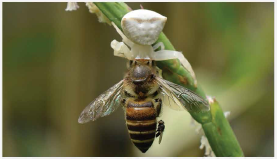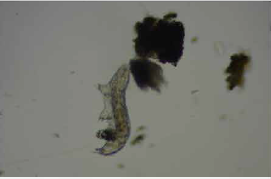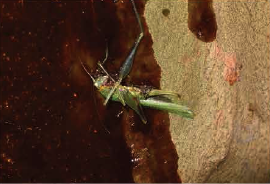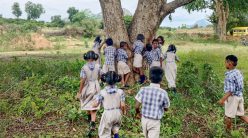Using IISc’s biodiversity for undergraduate education

“How many of you noticed the beautiful, white-coloured, fragrant tree just outside the stairs that lead us here to the lecture hall?” I asked the first year UG students in my first class of organismal biology at IISc. Barely two or three uncertain hands were raised out of 120.
“Go see that tree. It is called Murraya paniculata in Latin,” I said. ”And remember, this is what I am going to make you all do in the course.”
I told them that all my lab sessions, field experiments and one-to-one discussions will focus on making them more observant and curious about what we have around us. That I wanted them to pick up or photograph any curious object and bring them to me. That I was going to make them think and ask crazy questions, and try to turn them into naturalists, at least initially. All of this was going to test their patience, I warned them. “Be ready to hear answers that may astonish or disappoint you. Be ready to conduct experiments where there is no definite end result,” I said.
And in return, I got some smiling faces, perhaps thinking, “That’s it? We are going to look at different species and report back? That’s easy!” But others had faces that said, “This is ridiculous! There should be some complex experiments to make biology interesting.”
I see such stunned faces every time I say this to a new batch of undergrad students. They watch documentaries, read research papers and textbooks, go for tuitions, attend lectures, scientific and public talks; participate in conferences, and often present at conferences. This gives them a preliminary idea about what research involves. But when it comes to conducting research on their own, they often struggle with two foundational questions: Where to begin? How to start?
I like to teach ecology in a rather simple manner. I let them go out of the classroom and ask them to explore on their own. I ask them to consider any species and ask any interesting question. I put forth just one condition that they should not read anything about it prior to this exercise. I’ve seen that they take random walks and come back asking where to start. And this is the point where I like to begin. By this time, students also realise that there is no fixed syllabus for the course and it is quite open-ended. This makes the course and my teaching rather unstructured but also, I hope, interesting.
I like to teach ecology in a rather simple manner. I let them go out of the classroom and ask them to explore on their own
For every biologist, the most fundamental quality is to be observant, and the habit of exploring nature nurtures that quality. I believe that every person is fundamentally fascinated by nature. Everyone has curious questions about a particular animal or plant: What is its name? How do I identify it? Where does it live? Is it a male or female? What does it eat? How does it eat?
Asking all these questions contributes to understanding the organism’s natural history. I believe that everyone loves to do it. Some take it more seriously and scientifically, others treat it as a hobby. For me, it is both, and IISc provides that opportunity to a great extent. The campus has over 100 species of birds, 100 species of ants, 50 species of spiders, and a myriad of other invertebrates including beetles, bugs, wasps, dragonflies, flies, and more. With each species, I see a new undergraduate project. Ever since I joined IISc, I have been utilising this biodiversity to teach my students in various ways.
If students wish to know or understand how to estimate distribution of species, how one habitat is different from another, or what kind of sampling and field methods to follow, I use ants. Such experiments require collection of specimens, labelling and preservation and, at times, observing them in situ. The focal species should be visible enough, should not be scarce, and should be readily available. Collecting a few individuals should not disturb the species or break any environmental, biodiversity or wildlife law. Ants are ideal for this, and are abundant, with over 100 species on campus. Collecting one individual out of thousands of ants in a colony does not affect any behaviour or balance in the ecosystem as such. Ants are also easy to preserve and observe without needing much equipment. I’ve seen that after observing ants closely, students end up understanding beyond the layman’s classification of ants i.e. ‘black ants vs. red ants’ or ‘the ones that bite vs. the ones that do not’.

Some students then wish to understand how multiple species interact with each other. I ask them to start looking for spiders. I have documented about 60 species of spiders on the IISc campus. They are more diverse in terms of their body shape, habits and behaviour than ants. They are not as easy to find as ants, nor are they as abundant. Their diverse interactions with their prey, co-predators and competitors make them very interesting to study. Once, while teaching trophic interactions, I took students out in the field and we saw an amazing demonstration of multitrophic interactions on a single grass twig: a crab spider laying an ambush for an insect visitor (maybe coming for pollen) caught a honey bee which a fly then tried to eat parasitically.
My experience tells me that pulling students out of the controlled environment of labs makes them start thinking on their own. One student approached me and asked if she can study sexual selection in animals. She was curious to study the Indian peafowl, and had come up with some preliminary protocols and field methods independently. I asked her to go and find a place where a large number of peacocks can be seen. She went around Bangalore and found a place where, at a time, two or three can be seen. But this sample size was too small, so I introduced her to guppies. They are a sexually dimorphic abundant fish species found all over the campus. They are easy to maintain in the lab and observe, and useful for doing controlled experiments. She then decided to study them to learn more about their mating choices.

In another instance, inspired from my talk in the very first class, a few students brought lichen and moss samples from trees to observe under the microscope. They found a curious worm-like object which turned out to be a tardigrade – a hardy microscopic creature. The students were thrilled to learn that tardigrades can survive the effects of outer space, UV radiation, starvation and desiccation, and the fact that they can be found so easily on the IISc campus. They wanted to extract a few and maintain them in the labs. And so experiments began and they are still going on.
In all of the above cases, I did not suggest any research protocol to them, and rather asked them to develop it on their own. This exercise was needed as it gave them confidence to think independently, to design their own research methods and troubleshoot problems. This is what a researcher or a scientist is primarily required to do.
Training students to think on their own is crucial because while pursuing a research career, one has to come up with a question and design protocols for experiments, arrange for sampling, and so on.
Many research advisors have a system in which they give students an idea (or in fact a ready-made question), or ask them to start going through scientific literature and find out what the missing points – fashionably known as ‘research gaps’ – are, and start figuring out a question out of these. I must say that these are completely rational approaches. This also saves time and money. Even students find it very interesting in the beginning. But I see some shortfalls in this. By having a ready research question provided by the research advisor, students may end up doing what is interesting for the advisor, not for themselves. They may do what their supervisors say but not what they themselves would want to do.

It should be noted that I said ‘research advisor’ and not ‘PhD advisor’. I have noticed that this problem is equally prevalent among bachelor’s and master’s students who conduct research as part of their curriculum. There are only a handful of instances where students’ interests and advisors’ interests match. Training undergraduate and master’s students to think on their own may also not be prioritised given the short duration of their programmes and the emphasis on imparting new skills or techniques rather than research.
Having faced such situations during my undergrad years, I have realised the importance of teaching ecology differently to get students exposed to the fundamentals of research.
Today, students have unlimited access to knowledge. They are sometimes more adept at gathering facts than most of their teachers. The only thing that they lack is a systematic approach to using this information. I think teachers today should not try to compete with Google but rather try to train students to use the information they already have in more systematic and creative ways.
Abhijeet Bayani is an undergraduate instructor at IISc.




